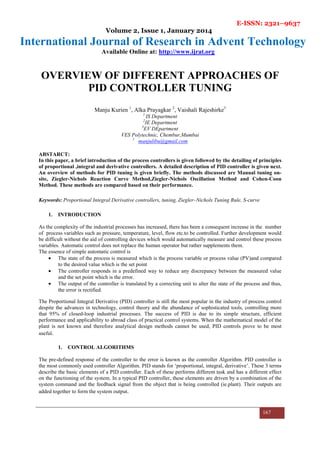This document provides an overview of different approaches for tuning PID controllers. It first introduces PID controllers and their proportional, integral and derivative terms. It then describes several common methods for tuning PID controllers, including manual tuning on-site, Ziegler-Nichols reaction curve method, Ziegler-Nichols oscillation method, and Cohen-Coon method. These tuning methods are compared based on their performance and applicability to different process control systems.








![E-ISSN: 2321–9637
Volume 2, Issue 1, January 2014
International Journal of Research in Advent Technology
Available Online at: http://www.ijrat.org
175
Table 5: Comparison of different tuning methods
Method Advantages Disadvantages
Manual Tuning Online method.
Requires experienced personnel.
No math required
Ziegler–Nichols Proven Method. Online method.
Process upset, some trial-and-error,
very aggressive tuning. Used only
for process control systems.
Software Tools
Consistent tuning. Online or offline
method. May include valve and
sensor analysis. Allow simulation
before downloading. Can support
Non-Steady State (NSS) Tuning.
Some cost and training involved.
Cohen-Coon Good process models.
Offline method. Only good for
first-order processes.
Acknowledgments
The authors would like to gratefully acknowledge the help of the college authorities during the preparation
of this manuscript.
References
[1] www.auma.com
[2] www.google.co.in/picturesofPID
[3] www.eetindia.com
[4] PID controller tuning: a short tutorial by JinghuaZhong.
[5] Modern control engineering by K.Ogata
[6] K.j.Astrom,R.M.Murray; Feedback system-an introduction for scientists and engineers
[7] www.mathworks.com](https://image.slidesharecdn.com/paperid-21201482-140828020545-phpapp02/85/Paper-id-21201482-9-320.jpg)